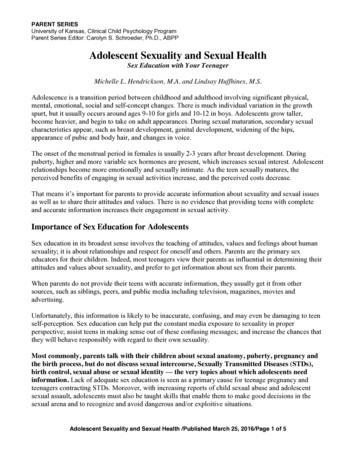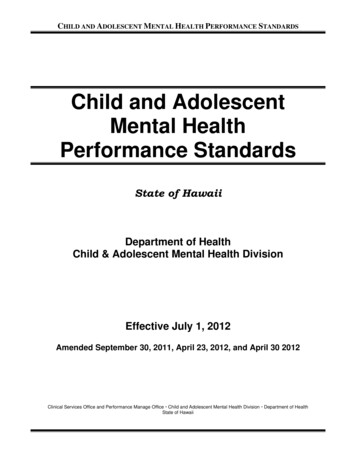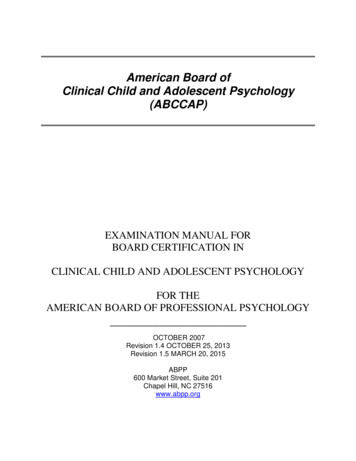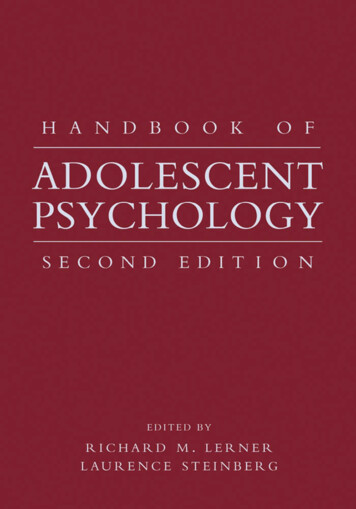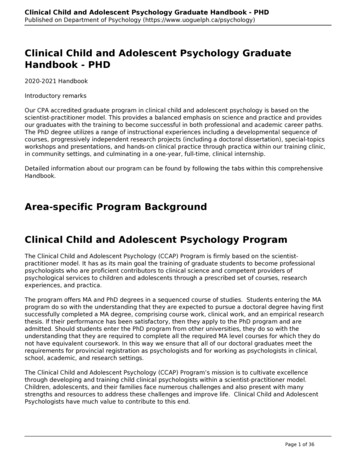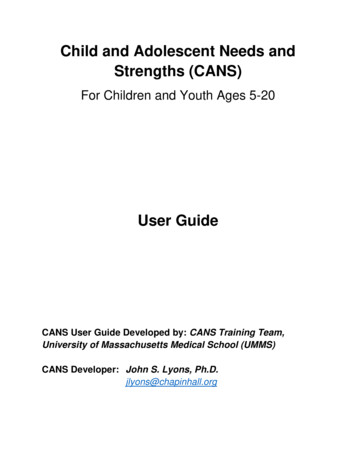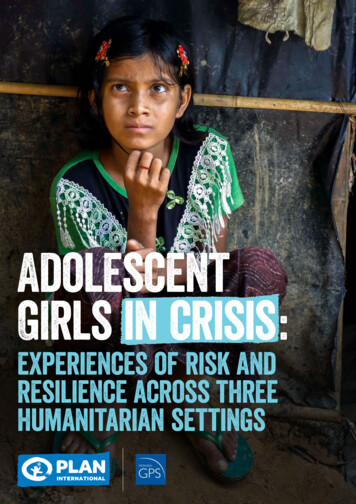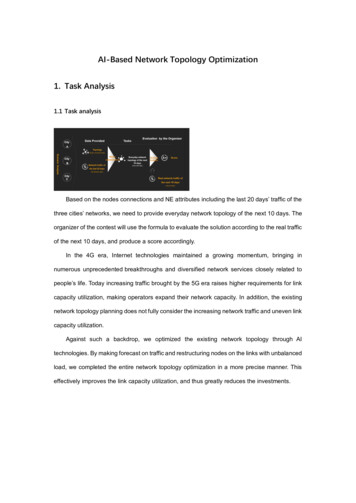
Transcription
Understandingthe Links BetweenAdolescent Traumaand Substance AbuseA Toolkit for Providers2nd EditionJune 2008From the Adolescent Trauma and SubstanceAbuse Committee of the National Child TraumaticStress NetworkThis project was funded by the Substance Abuse and Mental Health ServicesAdministration (SAMHSA), US Department of Health and Human Services(HHS). The views, policies, and opinions expressed are those of the authorsand do not necessarily reflect those of SAMHSA or HHS.Established by Congress in 2000, the National Child Traumatic Stress Network(NCTSN) is a unique collaboration of academic and community-based servicecenters whose mission is to raise the standard of care and increase access toservices for traumatized children and their families across the United States.Combining knowledge of child development, expertise in the full range of childtraumatic experiences, and attention to cultural perspectives, the NCTSNserves as a national resource for developing and disseminating evidence-basedinterventions, trauma-informed services, and public and professional education.
AcknowledgmentsThis toolkit was developed by the Adolescent Trauma and Substance Abuse Committee of theNational Child Traumatic Stress Network to raise awareness about the needs of youth with traumaticstress and substance abuse problems and to promote evidence-based practices in clinical settings. Itis meant to serve as a training guide for providers working with this population.Toolkit Editor and Substance Abuse Committee Chair: Liza Suárez, PhD, now at the Institute forJuvenile Research, University of Illinois at ChicagoSubstance Abuse Committee Co-Chairs: Luis Flores, MALPC, LCDC, RPT-S, SCAN’s Border TraumaticStress Response Center, Laredo, TX and Lucy Zammarelli, MA, NCAC II, Willamette Family TreatmentServices, Eugene, ORCoordinating Center: Adolescent Traumatic Stress and Substance Abuse Treatment Center, Centerfor Anxiety and Related Disorders at Boston University, Boston, MANCTSN Adolescent Trauma and Substance Abuse Committee CentersAddiction Technology TransferCenter of New England andCenter for Alcohol and AddictionStudies at Brown UniversityProvidence, RIAdolescent TraumaTreatment ProgramThe Mental Health Centerof Dane Co., Inc.Madison, WIChestnut Health SystemsBloomington, ILChild & Adolescent TraumaticStress Center ofSouthern ArizonaTucson, AZChildren’s Hospital Los AngelesLos Angeles, CADivision of Child MentalHealth ServicesWilmington, DENational Crime VictimsResearch and Treatment CenterMedical University ofSouth CarolinaCharleston, SCNational Institute of Drug AbuseBethesda, MDSubstance Abuse andMental Health ServicesAdministrationRockville, MDWillamette FamilyTreatment ServicesEugene, ORYouth Health ServicesElkins, WVNational Center onFamily HomelessnessNewton Centre, MASCAN’s Border TraumaticStress Response CenterLaredo, TXToolkit Edits Subcommittee Coordinator: Ayme Turnbull, PsyD, North Shore-LIJ Health System,Manhasset, NYThe NCTSN Adolescent Trauma and Substance Abuse Committee would like to extend a special thankyou to the staff of the Adolescent Traumatic Stress and Substance Abuse Treatment Center at BostonUniversity for providing much of the foundational and coordination work for this toolkit. Understanding the Links Between Adolescent Trauma and Substance AbuseJune 2008
ContentsI.Making the Connection: Trauma and Substance Abuse. 5General information about the links between trauma and substance abuse inadolescentsII.Understanding Traumatic Stress In Adolescents:A Primer for Substance Abuse Providers. 13Information on the prevalence of trauma exposure, the long-term consequences oftrauma, and information on specific trauma typesIII.Understanding Substance Abuse In Adolescents:A Primer for Mental Health Professionals. 25Information on the prevalence of substance abuse, its long-term consequences,and information on specific substances of abuseIV.Treatment for Youth with Traumatic Stress and Substance Abuse Problems. 49Information on treatment recommendations and evidence based interventions foradolescent substance abuse and traumatic stress, including integrated treatmentstrategies for teens with both disordersV.Engaging Adolescents In Treatment. 67Strategies for enhancing adolescent engagement in treatmentThe National Child Traumatic Stress Networkwww.NCTSN.org
Making the Connection:Trauma and Substance AbuseWhen Mary was 11, her mother “left this man, Dave” to babysit. Dave gave hera joint. “It made me happy. It made me feel like nothing could touch me andeverything was OK. So I started stealing my mum’s drugs.” Of course, she wascaught and locked in a closet. “I was in there for almost two days. After thathappened, I guess a part of me changed. I didn’t care for anybody. I hated theworld after that.”1Data from the most recent National Survey of Adolescents and other studies indicatethat one in four children and adolescents in the United States experiences at least onepotentially traumatic event before the age of 162, and more than 13% of 17-year-olds—onein eight—have experienced posttraumatic stress disorder (PTSD) at some point in theirlives.3Most, if not all, of these young people also have access to a wide range of psychoactivesubstances that can both dull the effects of stress and place teens at increased riskof experiencing trauma. It is estimated that 29% of adolescents–nearly one in three–haveexperimented with illegal drugs by the time they complete 8th grade, and 41% haveconsumed alcohol.4 For many adolescents, such early experimentation eventually progressesto abuse of—or dependence on—illicit drugs or alcohol. Every year, approximately one in fiveAmerican adolescents between the ages of 12 and 17 engages in abusive/dependent orproblematic use of illicit drugs or alcohol.5,6Although it is unclear exactly how many adolescents who abuse drugs or alcohol also haveexperienced trauma, numerous studies have documented a correlation between traumaexposure and substance abuse in adolescents:nIn the National Survey of Adolescents, teens who had experienced physical orsexual abuse/assault were three times more likely to report past or currentsubstance abuse than those without a history of trauma3nIn surveys of adolescents receiving treatment for substance abuse, more than 70%of patients had a history of trauma exposure7,8This correlation is particularly strong for adolescents with PTSD. Studies indicate that up to59% of young people with PTSD subsequently develop substance abuse problems.8–11The National Child Traumatic Stress Networkwww.NCTSN.org
Traumatic Stress and Substance Use: A Complex RelationshipMultiple pathways have been proposed to explain the temporal link between trauma andsubstance abuse in adolescents.12 A review of these theories demonstrates that the roadconnecting these disorders runs both ways: trauma increases the risk of developing substanceabuse, and substance abuse increases the likelihood that adolescents will experience trauma.Trauma as a risk factor for substance abuseAccording to the self-medication hypothesis of substance abuse, people develop substanceabuse problems in an attempt to manage distress associated with the effects of traumaexposure and traumatic stress symptoms. This theory suggests that youth turn to alcoholand other drugs to manage the intense flood of emotions and traumatic remindersassociated with traumatic stress or PTSD, or to numb themselves from the experience of anyintense emotion, whether positive or negative.Several studies have found that substance use developed following trauma exposure(25%–76%) or the onset of PTSD (14%–59%) in a high proportion of teens with substanceabuse disorders.8–11 Recent research in this area also suggests that traumatic stress orPTSD may make it more difficult for adolescents to stop using, as exposure to remindersof the traumatic event have been shown to increase drug cravings in people with cooccurring trauma and substance abuse.13,14 (For more information on trauma reminders, seeUnderstanding Traumatic Stress in Adolescents: A Primer for Substance Abuse Professionals.)Substance abuse as a risk factor for traumaNumerous epidemiological studies have found that, for many adolescents (45%–66%),substance use disorders precede the onset of trauma exposure.9–11 Studies have showna direct link between alcohol use and engagement in risky behaviors in which adolescentsmay get hurt10, such as hitchhiking, walking in unsafe neighborhoods, and driving after usingalcohol or drugs.15 According to the most recent National Survey on Drug Use and Health,more than 25% of underage drinkers are binge or heavy drinkers, and approximately 20%—one in five—report driving while under the influence during the past year.5 Not surprisingly,adolescents with substance abuse disorders are also significantly more likely than their nonsubstance abusing peers to experience traumas that result from risky behaviors, includingharm to themselves or witnessing harm to others.9–11There is also evidence that youth who are already abusing substances may be less ableto cope with a traumatic event as a result of the functional impairments associated withproblematic use. In one study, investigators found that even after controlling for exposure totrauma, adolescents with substance abuse disorders were two times more likely to developPTSD following trauma than were their non-abusing peers. The researchers suggestedthat the extensive psychosocial impairments found in adolescents with substance abuse Understanding the Links Between Adolescent Trauma and Substance AbuseJune 2008
disorders occurred in part because theylacked the skills necessary to cope withtrauma exposure.10Regardless of the pathway describing theonset of trauma exposure or PTSD and thedevelopment of substance abuse problems,youth with this co-occurrence experiencedifficulties with emotional and behavioralregulation that make it all the more difficultfor them to stop using. A successfultreatment approach must therefore beflexible enough to accommodate the multipleways in which trauma and substance abusemay be related.Addressing the Needs ofAdolescents with Co-occurringTrauma and Substance AbuseFor adolescents dealing with the effectsof traumatic stress or PTSD, alcohol and/or drugs initially may seem to alleviatedistress, either through the increasedpleasurable sensations or through theavoidance of intense emotions that mayfollow stressful experiences. In the long run,however, substance use perpetuates a cycleof problem behaviors that can make it moredifficult to recover after a traumatic event.For teenagers struggling with substanceabuse and traumatic stress, the negativeeffects and consequences of one disordercompound the problems of the other.Raphael’s* StoryRaphael was a 15-year-old boy with a history oftruancy and drug involvement (marijuana use anddrug dealing). He had been placed in a grouphome after Child Protective Services becameinvolved with the family and his mother andstepfather asserted that they “couldn’t control”Raphael.In the group home, Raphael was angry,threatening, and unwilling to cooperate withgroup activities. He was disruptive during grouptherapy sessions and initially refused to saymuch during individual treatment sessions.Through patience, openness, and a willingnessto explore Raphael’s interests—including his flairfor developing spontaneous rhymes and rap-stylelyrics—Raphael’s therapist was gradually able toengage Raphael in the treatment process.Over time, Raphael opened up about his difficultrelationship with his mother, being frequentlyhit and locked in a dark closet by his stepfather,and his conflicted relationship with his youngersister. He also talked about his frequent, almostdaily, use of marijuana and alcohol and how theymade him feel “better” and “on top of things.”It became clear that, for Raphael, alcohol andmarijuana served as tools that enabled himto numb overwhelming feelings and to feeldominant in uncomfortable or threatening socialsituations. As Raphael and his therapist beganto address his trauma and substance abusehistories, Raphael started to develop better toolsfor coping with the intense feelings and impulsesthat contributed to his most pressing problems.* “Raphael” is a composite representation based onreal teenage clients struggling with traumatic stressand substance abuse.Although such teenagers need help, oftendesperately, they frequently have difficultyentering or staying involved in treatment services. Usually teenagers attend such facilitiesagainst their will—because they are either mandated to attend treatment (i.e., by the courts),referred by teachers, or brought in by their parents.The National Child Traumatic Stress Networkwww.NCTSN.org
Because the service systems targeting substance abuse and mental health problems havetraditionally been fragmented, few teenagers with both traumatic stress and substanceabuse problems receive integrated treatment services. Compounding the problem is thatthere are few facilities offering integrated services, primarily because few professionaltraining programs in substance abuse or mental health provide clinicians with the educationnecessary to develop expertise in both trauma and substance abuse treatment, and fewprofessionals have training and experience across both fields.Given the strong link between trauma and substance abuse among adolescents, however,the majority of both substance abuse and mental health professionals have encounteredthis population. Providing adequate and effective care to adolescents who are grappling withsubstance abuse and trauma will require adjustments on the part of both groups.For mental health providers, it is critical to become familiar with the patterns of addictionassociated with substances of abuse, and to recognize that similar patterns are at workin traumatic stress and addiction. Both are characterized by emotional and behavioraldysregulation, and are expressed in a range of symptoms and behaviors that can includeclassic posttraumatic stress symptoms, substance abuse, and other risky behaviors.For substance abuse professionals, it is important to look beyond the immediatecircumstances of the youth’s substance use and pay attention to his or her trauma historyand its relationship to his or her current emotional difficulties and coping patterns (includingsubstance use). There are many commonalities between the ways in which youth respondto substance abuse triggers and the ways in which they respond to reminders of loss andtrauma. Compiling a list of triggers that may lead to emotional dysregulation and substanceuse, and incorporating possible reminders of previous trauma and loss can be helpful.Overcoming Common Challenges to CareClinicians, administrators, and other healthcare providers in the substance abuse and mentalhealth fields often face major challenges in providing care to youth with traumatic stress andsubstance abuse problems. For example, the fragmentation that has traditionally existedbetween mental health and substance abuse systems often limits the types of servicesthat youth are eligible to receive. Additionally, service centers may lack the resources orsupport necessary to provide comprehensive services. Although it may not be possible tofind solutions to many of these challenges, below are some solutions to common treatmentproblems. Understanding the Links Between Adolescent Trauma and Substance AbuseJune 2008
CHALLENGESUGGESTED SOLUTIONLack of institutional awareness and prioritizationof adolescent trauma and substance useassessment and treatmentThe materials in this toolkit can serve as resources toaid in raising institutional awareness of the need forsound substance abuse and trauma assessment andtreatment. Presenting case material that highlights therelationships between trauma and substance abuse canalso help raise institutional awarenessClinician lack of familiarity with the commonpresentations of posttraumatic stress symptomsin adolescentsUse the materials in this toolkit to help become familiarwith the common presentations of posttraumatic stresssymptoms in adolescents. Access more information viathe National Child Traumatic Stress Network website:www.NCTSN.orgTime and costs associated with conductingstandardized assessments and training staff touse evidence-based interventionsTo convince institutional administrators to invest thetime and money required for the initial stages of suchprogram development, present them with research onimproved treatment adherence and treatment outcomeswhen standardized assessments and evidence-basedinterventions are employed. Once the program has beenestablished and youth outcomes are improved, workingwith youth will be more rewarding, which may encourageadministrators to seek additional funding opportunitiesAdolescents with severe co-occurring disordersoften require assistance with other practicalaspects of life–such as transportation,schooling, court advocacy, health insurance–thatnot all institutions are equipped to providePartnerships with local agencies can often go a longway towards meeting the practical needs of clients whenthey cannot be met by a single organizationDifficulty engaging adolescents with trauma andsubstance abuse histories–who often employavoidant coping mechanisms–in treatmentUse the tips in this toolkit to help engage adolescentsin treatment. For clinicians struggling to engage difficultclients: access institutional support, including additionalsupervisionLack of local substance abuse and traumatraining resourcesSearch the Internet for substance abuse and traumatraining resources. To reduce the cost of face-toface training sessions, agencies can send a singlerepresentative to be trained, who can subsequently trainhis/her colleaguesConclusionAdequate care begins with the recognition and accurate identification of the problemsthese adolescents experience, whether they present to a mental health professional or toa substance abuse specialist. Rather than referring a multi-problem teenager to anotherprovider, clinicians willing to address co-occurring disorders can develop the skills necessaryto provide such adolescents with hope of recovery.The National Child Traumatic Stress Networkwww.NCTSN.org
Therapists and counselors can develop skills to provide a comprehensive and integratedtreatment approach. In order to maximize an adolescent’s chances of success, this approachshould broadly address the adolescent’s concerns and take into account the functionalrelationship between traumatic stress and substance abuse problems. When developing anindividualized treatment plan, special attention should be given to the signs and symptomsof posttraumatic stress, substance abuse, and the relationship between the two.This toolkit has been developed to assist mental health and substance abuse professionalsin providing comprehensive assessment and treatment to adolescents suffering fromtraumatic stress and substance abuse. It explores the complex connections betweentraumatic stress and substance abuse and provides guidelines for identifying, engaging, andtreating adolescents suffering from these co-occurring problems.Trauma and Substance Abuse: Myths and FactsMYTH: Since most adolescents who use drugs and/or alcohol have experienced some kind of trauma,there is no need to treat trauma as a unique clinical entity.FACT: Although not all youth who experience traumatic events develop PTSD, it is important to beprepared to address the multiple ways youth respond to trauma. Traumatic stress and PTSD areassociated with unique (and challenging) symptoms that require targeted, trauma-informed treatmentto optimize recovery. (For more information, see Understanding Traumatic Stress in Adolescents: APrimer for Substance Abuse Professionals.) Effective treatment approaches and interventions havealready been developed for patients suffering from traumatic stress and PTSD. Making use of thesetechniques as part of a comprehensive treatment plan offers the greatest hope of treatment successfor adolescents dealing with the effects of substance abuse and traumatic stress.MYTH: When dealing with an adolescent who has a history of trauma and substance abuse, you needto treat one set of problems at a time.FACT: Because the symptoms associated with traumatic stress and substance abuse are so stronglylinked, the ideal treatment approach is to address both conditions. Unfortunately it is not uncommonfor substance abuse programs to deny admission to patients with PTSD, and for trauma treatmentprograms to deny admission to patients who have not achieved sobriety. The decision about whichsymptoms and behaviors to address first therefore requires a careful assessment of the relative threatthat each condition poses to a youth’s safety, health, and immediate well-being.10Understanding the Links Between Adolescent Trauma and Substance AbuseJune 2008
References1. Gardner, D. (2002). Skid Row High. The Ottawa Citizen. April 21, 2002.2. Costello, E. J., Erkanli, A., Fairbank, J. A., and Angold, A. (2002). The prevalence of potentiallytraumatic events in childhood and adolescence. J Trauma Stress, 15(2), 99-112.3. Kilpatrick, D. G., Saunders, B. E., and Smith, D. W. (2003). Youth Victimization: Prevalence andImplications. Washington, DC: U.S. Department of Justice, Office of Justice Programs, NationalInstitute of Justice. Retrieved April 16, 2008 from http://www.ncjrs.gov/pdffiles1/nij/194972.pdf.4. Johnston, L. D., O’Malley, P. M., Bachman, J. G., and Schulenberg, J. E. (2007). Monitoring theFuture: National results on adolescent drug use: Overview of key findings, 2006. Bethesda, MD:National Institute on Drug Abuse. Retrieved April 16, 2008 from /overview2006.pdf.5. Substance Abuse and Mental Health Services Administration. (2007). Results from the 2006National Survey on Drug Use and Health: National Findings. Rockville, MD: Department ofHealth and Human Services. Retrieved April 7, 2008 from s.pdf.6. Knight, J. R., Harris, S. K., Sherritt, L., Van Hook, S., Lawrence, N., Brooks, T., et al. (2007).Prevalence of positive substance abuse screen results among adolescent primary care patients.Arch Pediatr Adolesc Med, 161(11), 1035-41.7. Funk, R. R., McDermeit, M., Godley, S. H., and Adams, L. (2003). Maltreatment issues by level ofadolescent substance abuse treatment: The extent of the problem at intake and relationship toearly outcomes. Child Maltreat, 8(1), 36-45.8. Deykin, E. Y., and Buka, S. L. (1997). Prevalence and risk factors for posttraumatic stressdisorder among chemically dependent adolescents. Am J Psychiatry, 154(6), 752-7.9. Clark, D. B., Lesnick, L., and Hegedus, A. M. (1997). Traumas and other adverse life events inadolescents with alcohol abuse and dependence. J Am Acad Child Adolesc Psychiatry, 36(12),1744-51.10. Giaconia, R, M., Reinherz, H. Z., Hauf, A. C., Paradis, A. D., Wasserman, M.S., and Langhammer,D. M. (2000). Comorbidity of substance use and post-traumatic stress disorders in a communitysample of adolescents. Am J Orthopsychiatry, 70(2), 253-62.11. Perkonigg, A., Kessler, R. C., Storz, S., and Wittchen, H. U. (2000). Traumatic events and posttraumatic stress disorder in the community: Prevalence, risk factors and comorbidity. ActaPsychiatr Scand, 101(1), 46-59.12. Giaconia, R. M., Reinherz, H. Z., Paradis, A. D., and Stashwick, C. K. (2003). Comorbidity ofsubstance use disorders and posttraumatic stress disorder in adolescents. In Oimette, P.and Brown, P. J. (Eds.), Trauma and substance abuse: Causes, consequences, and treatment ofcomorbid disorders (pp. 227-242). Washington, DC: American Psychological Association.The National Child Traumatic Stress Networkwww.NCTSN.org11
13. Saladin, M. E., Drobes, D. J., Coffey, S. F., Dansky, B. S., Brady, K. T., and Kilpatrick, D. G.(2003). PTSD symptom severity as a predictor of cue-elicited drug craving in victims of violentcrime. Addict Behav, 28(9), 1611-29.14. Coffey, S. F., Saladin, M. E., Drobes, D. J., Brady, K. T., Dansky, B. S., and Kilpatrick, D. G.(2002). Trauma and substance cue reactivity in individuals with comorbid posttraumatic stressdisorder and cocaine or alcohol dependence. Drug Alcohol Depend, 65(2), 115-27.15. Kann, L., Kinchen, S. A., Williams, B. I., Ross, J. G., Lowry, R., Grunbaum, J.A., et al. (2000).Youth risk behavior surveillance—United States, 1999. MMWR CDC Surveill Summ, 49(5), 1-96.12Understanding the Links Between Adolescent Trauma and Substance AbuseJune 2008
Understanding Traumatic Stressin Adolescents: A Primer forSubstance Abuse ProfessionalsHe that conceals his grief finds no remedy for it.Turkish proverbThe term “traumatic stress” generally refers to the physical and emotional response of anindividual to events that threaten the life or physical/psychological integrity of that person orof someone critically important to him or her. Traumatic stress characteristically producesintense physical and emotional reactions, including an overwhelming sense of terror,helplessness, and horror, and a range of physical sensations such as a pounding heart,trembling, dizziness, nausea, dry mouth and throat, and loss of bladder or bowel control.In children and adolescents, traumatic stress can be triggered by a wide range ofexperiences, including:nPhysical, sexual, or emotional abuse1nNeglect (failure to provide for a child’s basic physical, medical, educational, andemotional needs)nInterpersonal violence or victimization (e.g., assault, rape)2nCommunity violence (e.g., gang violence, riots, school shootings)3–6nNatural disasters (e.g., hurricanes, floods, tornadoes)7,8nTerrorism9,10nTraumatic loss or grief (e.g., murder of a parent or sibling, death of a parent inbattle)9,11–15nMedical trauma (e.g., severe injury, life-threatening illness)16–18nAccidents16The short- and long-term impact of any given traumatic event depends partly on the objectivenature of the event, and partly on the individual’s subjective response to it. For example, thetraumatic impact of interpersonal events such as physical or sexual abuse or victimizationmay vary depending on factors such as the identity of the perpetrator, the frequency of theabuse, and whether force was used. Not every distressing event results in traumatic stress,and something that is traumatic for one person may not be traumatic for another.The National Child Traumatic Stress Networkwww.NCTSN.org13
Types of Traumatic StressA single, time-limited traumatic event is called an acute trauma. A natural disaster, motorvehicle accident, physical or sexual assault, or a school shooting are all examples of acutetraumas. Over the course of even a brief event, a child or adolescent may go through avariety of complicated sensations, thoughts, feelings, and physical responses that arefrightening in and of themselves and contribute to his or her sense of being overwhelmed.The loss of someone critically important (e.g. a parent, sibling, or close friend) is an acuteevent that can lead to a traumatic stress reaction known as traumatic grief. Although alladolescents grieve after the death of a loved one, traumatic grief occurs when the teenexperiences the death/loss as a traumatic event and experiences many of the symptomsof PTSD (e.g., intrusive thoughts about the death, increased physical agitation, emotionalnumbing).13–15 These symptoms hinder the natural bereavement process, can causeinterference in daily functioning, and do not allow the teen to process and, eventually, let goof the loss.13–15 Traumatic grief is often complicated by the secondary consequences of theloss, such as moving in with grandparents after the loss of a parent.14The experience of multiple traumaticevents is referred to as chronic trauma.Chronic trauma may encompass severaldifferent events—such as exposureto domestic violence, involvement in aserious car accident, and exposure togang-related violence—or longstandingtrauma such as physical abuse or war.One common from of chronic trauma ischild neglect.The effects of chronic trauma tend to becumulative, because each event servesas a reminder of the prior trauma andreinforces its negative impact. A childor adolescent who has been exposedto a series of traumas may becomeincreasingly overwhelmed with eachsubsequent event and more convincedthat the world is not a safe place. Overtime, he or she may also become lessable to tolerate ordinary everyday stress.14A Word about Trauma RemindersTrauma reminders are people, situations, places,or things that evoke past traumatic events. Whenfaced with trauma reminders, adolescents mayreexperience the intense and disturbing feelingstied to the original event. Sometimes adolescentsare aware of their reaction and its connection tothe original event. More often, however, they areunaware of the root cause of their feelings, andmay even feel frightened by the intensity of theirreaction. As a result, traumatized teens may:nRespond recklessly, taking more risks orabusing drugs or alcoholnWithdraw from activities, places and friendsin an effort to avoid remindersnFear that their strong reactions mean theyare “going crazy”nFeel stigmatized by having gone throughtraumatic events, and feel that they cannottalk about themUnderstanding the Links Between Adolescent Trauma and Substance AbuseJune 2008
Complex trauma is a term used by some experts to describe both exposure to chronictrauma—usually caused by adults entrusted with the child’s care, such as parents orcaregivers—and the impact of such exposure on the person.19 Children and adolescents whohave experienced complex trauma have endured multipl
PTSD may make it more difficult for adolescents to stop using, as exposure to reminders of the traumatic event have been shown to increase drug cravings in people with co-occurring trauma and substance abuse.1 ,14 (For more information on trauma reminders, see



